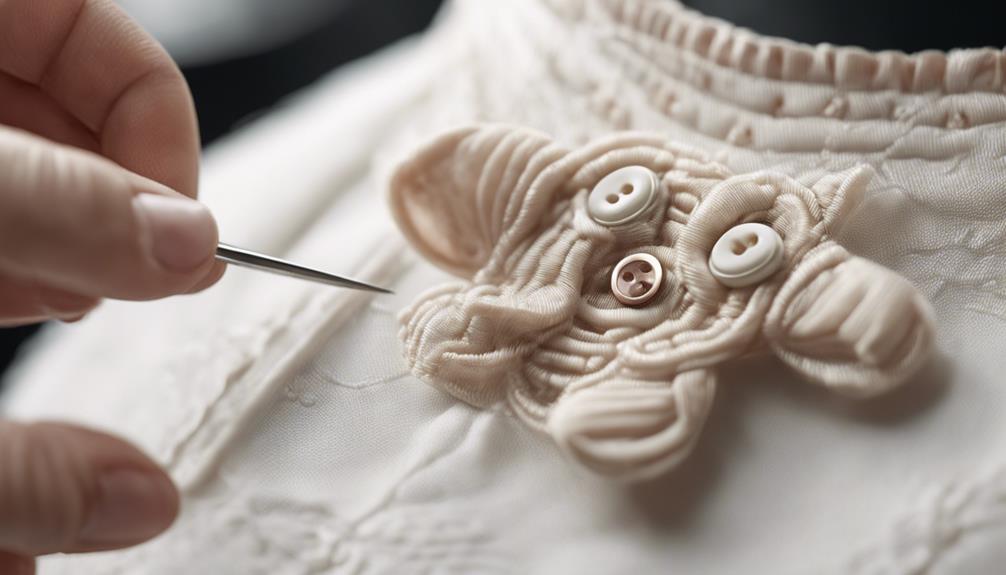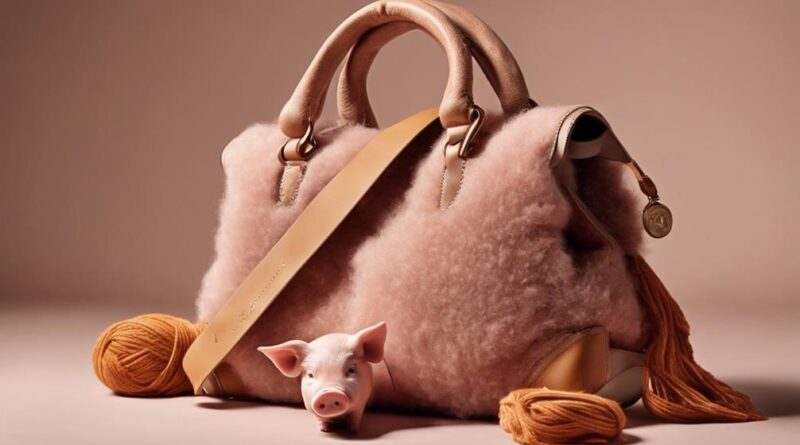Top 10 Pig By-products Utilized in Fashion Industry
In a world where fashion trends constantly evolve, have you ever paused to consider the surprising role pig by-products play in the industry?
From pig leather to gelatin, these versatile materials are quietly transforming the way we think about clothing and accessories.
As you explore the top 10 pig by-products utilized in the fashion industry, you'll uncover a fascinating intersection between sustainability, innovation, and style that may just surprise you.
Pig Leather in Fashion
When considering sustainable fashion choices, opting for pig leather over traditional cow leather can significantly reduce environmental impact. Pig leather is gaining popularity in the fashion industry due to its sustainable sourcing and ethical production practices. Unlike cow leather, which is a byproduct of the meat industry and often involves intensive farming practices, pig leather is sourced as a byproduct of the food industry, reducing waste and promoting a more sustainable approach.
Pig leather is often sourced from pigs raised in smaller, more ethical farming operations. These pigs are typically raised in better living conditions compared to mass-farmed cows, aligning with the principles of ethical production. By choosing pig leather, you're supporting more humane treatment of animals in the fashion supply chain.
Moreover, pig leather tends to be more environmentally friendly compared to cow leather. The production of pig leather generally requires fewer resources such as water and land, making it a more sustainable option for eco-conscious consumers. Additionally, pig leather can be processed using less harsh chemicals in the tanning process, further reducing its environmental impact.
Pig Hair and Boar Bristles
Pig hair and boar bristles offer alternative sustainable materials for various fashion and beauty products, expanding the eco-friendly options beyond pig leather in the industry. Pig hair accessories are gaining popularity due to their durability and unique texture, making them ideal for items like hair clips, hats, and even jewelry.
Boar bristle brushes are known for their ability to distribute natural oils, leaving hair smooth and shiny, making them a sought-after choice in the beauty industry.
In textiles, pig hair is being used to create innovative fabrics that are both lightweight and insulating. These textiles are finding their way into high-end fashion garments, adding a touch of luxury while being environmentally conscious.
On the other hand, boar bristles are being repurposed for art supplies like paintbrushes. The natural stiffness of boar bristles makes them perfect for creating precise brushstrokes, attracting artists looking for sustainable alternatives.
Gelatin for Textile Coatings
Consider using gelatin as a sustainable alternative for textile coatings in the fashion industry. Gelatin, derived from pig by-products, offers a biodegradable and eco-friendly option for coating fabrics. This innovative use of gelatin as a coating material showcases the textile industry's commitment to exploring sustainable materials.
In recent years, there's been a growing interest in finding gelatin alternatives for coatings in the textile industry. Manufacturers are increasingly looking for sustainable materials that can replace traditional synthetic coatings. Gelatin fits the bill perfectly, providing a biodegradable solution that aligns with the industry's push towards eco-conscious practices.
Textile industry innovations have paved the way for the adoption of biodegradable materials like gelatin in textile coatings. By utilizing pig by-products such as gelatin, fashion companies can reduce their environmental impact without compromising on quality or performance. This shift towards more sustainable practices not only benefits the environment but also appeals to consumers who are becoming more conscious of the materials used in the products they purchase.
Pig Suede Fabric
The utilization of pig suede fabric offers a luxurious and sustainable alternative for fashion designers seeking eco-friendly materials. Pig suede is a high-quality material that provides a soft, smooth texture similar to traditional suede, making it a popular choice in the fashion industry. This type of suede is made from the underside of pigskin, known for its durability and flexibility.
Fashion designers are increasingly turning to pig suede as one of the sustainable alternatives due to its minimal environmental impact. Unlike other types of leather, pig suede requires less processing and resources to produce, reducing the overall carbon footprint of fashion products. By using pig suede fabric, designers can create stylish and eco-conscious clothing and accessories without compromising on quality or aesthetics.
The environmental impact of pig suede fabric is relatively low compared to other materials commonly used in the fashion industry. Its production process generates less waste and consumes fewer resources, making it a more sustainable choice for environmentally conscious consumers. By incorporating pig suede into their collections, designers can meet the growing demand for eco-friendly fashion while still delivering luxurious and fashionable pieces.
Pigskin for Clothing
When looking for durable and versatile materials for clothing, pigskin emerges as a viable option in the fashion industry. Pigskin is often used as a sustainable alternative to other types of leather, offering a durable and flexible material for various clothing items. Its strength and natural water resistance make it a desirable choice for outerwear, shoes, and accessories.
In terms of environmental impact, pigskin can be seen as a more sustainable option compared to synthetic materials. The production of pigskin generates less waste and pollution than synthetic alternatives, contributing to a more eco-friendly approach in the fashion industry. Furthermore, utilizing pigskin for clothing helps in reducing the demand for new leather production, thus decreasing the environmental strain caused by intensive farming practices.
Pig Bristle Brushes
Using pig bristles, craftsmen create brushes that serve various purposes in industries ranging from cosmetics to painting. Brush manufacturing is a delicate process that requires attention to detail and quality materials. Pig bristle brushes are favored for their durability and flexibility, making them ideal for achieving precise strokes and blending techniques.
Here are four key points to consider when it comes to pig bristle brushes:
- Animal Welfare: Ethical sourcing of pig bristles is crucial to ensure the well-being of the animals involved in the process. Responsible brush manufacturers prioritize the ethical treatment of pigs, ensuring that they're raised in humane conditions.
- Sustainability: Bristle sourcing plays a significant role in the sustainability of pig bristle brushes. Sustainable practices involve utilizing bristles from pigs raised for meat consumption, reducing waste and maximizing the utility of the animal by-product.
- Versatility: Pig bristle brushes are known for their versatility and ability to cater to a wide range of industries. From makeup application to artistic painting, these brushes offer a reliable tool for professionals and enthusiasts alike.
- Quality: The natural properties of pig bristles, such as their ability to hold pigment and maintain shape, contribute to the high quality of brushes made from this material. Craftsmen value pig bristles for their performance and longevity, ensuring that users can achieve exceptional results with every stroke.
Pig Bone Buttons

Craftsmen in the fashion industry repurpose pig bones to create unique and sustainable buttons for clothing and accessories. These buttons aren't only stylish but also environmentally friendly, making them a popular choice for eco-conscious consumers. The use of pig bone in fashion extends beyond buttons; it's also utilized in crafting exquisite bone jewelry, adding an elegant touch to outfits.
Pig bone buttons offer a distinctive look, with each button showcasing the natural variations in the bone, creating a one-of-a-kind appeal. The durability of pig bone makes these buttons long-lasting, ensuring your clothing stays adorned with them for years to come. Additionally, the sustainable nature of pig bone buttons aligns with the growing trend of eco-friendly fashion, allowing you to make a style statement while reducing your environmental impact.
In the world of sustainable accessories, pig bone buttons stand out for their unique aesthetic and eco-conscious production. By choosing clothing and accessories adorned with pig bone buttons, you not only elevate your style but also support ethical and sustainable practices in the fashion industry. So, next time you're looking to add a touch of elegance to your outfit, consider opting for pig bone buttons for a chic and environmentally friendly choice.
Pig Fat for Textile Softeners
Pig fat serves as a common ingredient in textile softeners, providing a natural way to enhance the softness and comfort of clothing items. When looking for sustainable fashion choices, utilizing pig-derived emollients can be a viable option. Here are four reasons why incorporating pig fat into textile softeners can contribute to eco-friendly textiles:
- Natural Softening: Pig fat contains natural properties that help soften fabrics without the need for harsh chemicals, making it a great alternative for those looking to reduce their environmental impact.
- Moisturizing Benefits: Pig fat-based softeners not only make your clothes softer but also provide moisturizing benefits for your skin, creating a more comfortable wearing experience.
- Biodegradability: Unlike synthetic additives, pig fat is biodegradable, ensuring that the softening process doesn't harm the environment once washed away.
- Reduced Carbon Footprint: By opting for pig fat alternatives in textile softeners, you're supporting a more sustainable production process that minimizes the carbon footprint associated with traditional softening methods.
Frequently Asked Questions
Can Pig By-Products in the Fashion Industry Be Sourced Ethically and Sustainably?
When it comes to ethical sourcing and sustainability in the fashion industry, it's crucial to consider the market demand and consumer awareness.
By ensuring that pig by-products are sourced ethically and sustainably, fashion brands can meet the growing consumer interest in eco-friendly and cruelty-free products.
This shift towards responsible sourcing not only benefits the environment but also aligns with the values of socially conscious consumers.
How Do Pig By-Products Compare to Synthetic Alternatives in Terms of Durability and Quality?
When comparing pig by-products to synthetic alternatives in the fashion industry, the quality and durability are often superior. Pig leather, for instance, is known for its strength and longevity, outperforming many synthetic materials. Not only does it age gracefully, but it also retains its quality over time.
On the other hand, synthetic alternatives may lack the same level of durability and can deteriorate faster. Overall, pig by-products stand out for their durability and quality in fashion.
Are There Any Environmental Concerns Associated With Using Pig By-Products in Clothing and Accessories?
When using pig by-products in fashion, there are environmental concerns to consider. The production process can have an impact on the environment due to waste and resource usage.
Additionally, it's essential to address animal welfare concerns to ensure ethical sourcing of these materials.
What Are Some Lesser-Known Uses of Pig By-Products in the Fashion Industry?
When it comes to pig by-products in fashion, there are some innovative applications that might surprise you.
From utilizing pigskin for unique textures to incorporating pig hair into creative designs, the fashion industry is constantly exploring trending materials.
These lesser-known uses showcase a fashion-forward approach that pushes the boundaries of traditional materials, resulting in truly original and eye-catching pieces.
How Do Designers and Brands Ensure the Traceability and Transparency of Pig-Derived Materials in Their Products?
To ensure traceability and transparency in your products, designers and brands must closely monitor their supply chain. This involves tracking the sourcing of pig-derived materials, verifying animal welfare standards, and disclosing this information to consumers.
Conclusion
So next time you're shopping for fashion items, remember that pig by-products play a significant role in the industry.
From pig leather to pig hair and gelatin, these versatile materials are utilized in various ways to create stylish and functional clothing and accessories.
By understanding the different ways pigs contribute to fashion, you can make more informed choices as a consumer.
So embrace the pig by-products in fashion and appreciate their unique qualities!
